Zendikar Rising Mechanics
Zendikar Rising takes us back to a world known throughout the Multiverse for adventure and daring expeditions into the unknown. That kind of took a back seat with the existential interplanar threat known as the Eldrazi running around. But good news—they're gone! It's like a whole new world. There are unbelievable sights. You'll have indescribable feelings. Get ready for a thrilling chase in this wondrous place. Here are the mechanics, new and old.
Modal Double-Faced Cards
You're braving the unknown, so it's good to have options. Sometimes you need lands. Sometimes you need spells. You can have it all with this new twist on double-faced cards: modal double-faced cards.
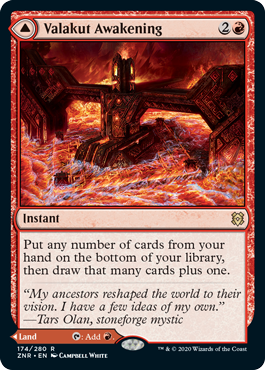
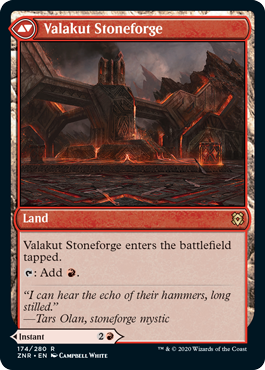
Like previous double-faced cards, modal double-faced cards have two card faces, one on each side of the card. But these cards don't transform. When you play a modal double-faced card, you choose which face you're playing. Short on mana? Play Valakut Stoneforge. Good on mana but need more action? Cast Valakut Awakening. It's up to you.
Most of the rules that govern how transforming double-faced cards apply to the new modal variety. While a modal double-faced card is in your hand, your graveyard, or exile, it has the characteristics of its front face only. So, if you're searching your library for a land card, you can't find a modal double-faced card whose front face isn't a land card. If an effect allows you to cast instant spells from your graveyard, you could cast Valakut Awakening, but you couldn't play Valakut Stoneforge.
When playing with double-faced cards, either the traditional transforming ones or their shiny new modal cousins, it's important to that your cards are indistinguishable from one another. To accomplish this, you can use opaque sleeves (and you probably already are), and you can also use these helper cards.

This helper card is a substitute for the actual double-faced card, which you must have in your possession. Write down the name of the card you're representing, along with any other information visible on the actual card. You can't use helper cards to jot down sideboarding notes, recipes, or anything not found on the card. During the game, if the card is in a public zone, swap in the real card. If it's in a hidden zone, use the helper card. Helper cards are optional, but you should use them or opaque sleeves, if not both.
Party
Paaaaaaaaarty! That's it. That's the intro.
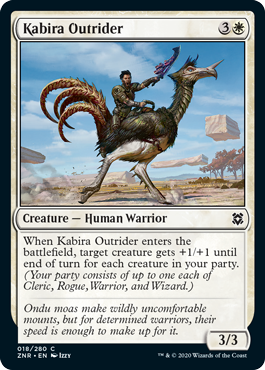
An homage to classic adventuring parties, the new party mechanic highlights four specific creature types: Cleric, Rogue, Warrior, and Wizard. The number of creatures in your party is how many of those roles you can fill with a creature you control. Each creature you control can fill a maximum of one role.
Abilities that care about the number of creatures in your party simply look for a number between 0 and 4. You never have to identify which creature is filling which role. Nothing will ask for the Cleric in your party, for example. Those abilities will use that number in various ways. Kabira Outrider uses it to calculate its bonus as its ability resolves. Other cards do . . . you know, other things. You'll see.
Some cards have bonuses if you have a "full party." That means all roles are filled—you control a Cleric, a Rogue, a Warrior, and a Wizard. Remember each of those creatures must be different creatures in case a creature has more than one party-relevant creature type.
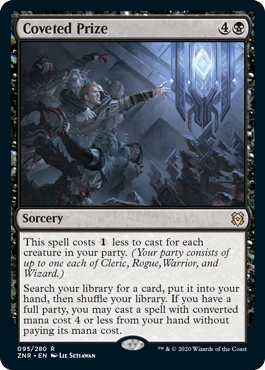
As you may expect, Zendikar Rising is full of Clerics, Rogues, Warriors, and Wizards ready to fill your ranks. Some creatures are more versatile than others.
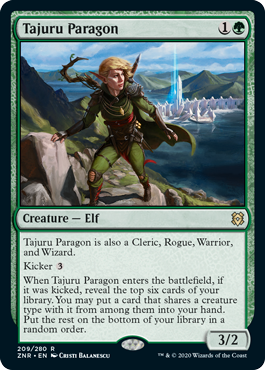
If you find yourself in a situation where you could count your party different ways to get different numbers, you always get the highest number. There are no choices involved. Big parties > small parties. If Tajuru Paragon is the only creature you control, there's one creature in your party. Get that Elf some friends!
Kicker
The party mechanic will have your whole tribe questing, while you kick it with a fan-favorite returning mechanic: kicker.
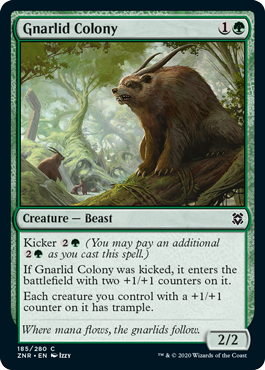
Kicker is an optional additional cost that appears on all kinds of cards. Simply put, you pay more, you get more. Gnarlid Colony is a serviceable two-drop if your curve calls for one, or you can wait until you have five mana and have it enter with two +1/+1 counters. Other permanents with kicker will have enters-the-battlefield triggered abilities that trigger only if they're kicked.
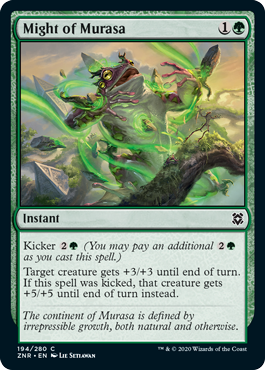
Instants and sorceries can also take advantage of kicker. On spells like Might of Murasa, kicking it might cause an alternative effect to happen. In this case, a +5/+5 bonus rather than the +3/+3 you get casting it without kicking it. Look for "instead" as your cue that the base effect is being replaced. Sometimes, kicking an instant or sorcery will give you an additional effect on top of the base one.
Spells with kicker offer flexibility: good in the early game, impactful once mana is plentiful. Speaking of plentiful mana . . .
Landfall
Lands have always been major players in Zendikar gameplay. The original Zendikar was conceived as a "lands matter" set, and Zendikar Rising continues that proud tradition by bringing back landfall. Landfall is an ability word found on abilities that trigger whenever a land enters the battlefield under your control.


This one's straightforward. If a land enters the battlefield under your control, all your landfall abilities will trigger. If more than one landfall ability triggers at the same time, you can put those abilities on the stack in any order. It doesn't matter why the land is entering the battlefield. It could be your land play for the turn. It could be a spell or ability that tells you to put a land card onto the battlefield.
Rise to the Challenge
Zendikar Rising takes us back to Zendikar, recapturing the spirit of exploration and adventure that made it one of the game's favorite worlds. New Skyclaves have appeared, new enemies and rivals have emerged, and glory awaits. Venture onward, Planeswalkers!

